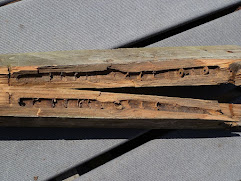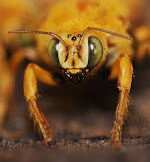Like many other species in the natural world, the male of the Valley Carpenter Bee (VCB) is flashier than the female. The males are a beautiful golden color, whereas the females are a flat black. She doesn’t get the looks, but she gets the size – the females are considerably bigger than the males. As a whole, carpenter bees (Xylocopa spp) are the largest bees in the US.
The VCB is a large, stout bee that may seem scary to some people, but it is generally a docile creature. This is due largely to the fact that they don’t have hives to protect. Instead of creating hives, the females build nests in wood (hence the “carpenter” moniker) in which to lay their eggs. They’ll tunnel into a wood host and creature multiple brood chambers. They will place a dollop of Bee Bread (a nutrient-packed, dough-like mixture of pollen, nectar and bee spit) in each chamber, lay an egg on top of it, and seal the chamber. The females will be in and out of the nest, collecting pollen and nectar, laying eggs and tending to offspring, storing pollen, or prepping the nest to be their winter home. These lady bees are not aggressive but will sting if you push them or mess with their nest.
 |
| carpenter bee tunnels |
While female VCB are tireless and social home-makers, the males are more solitary. According to this article, they will help their mate set up a nest and then will spend the remaining weeks of their lives in the area around the nest they’ve made. They do not live in the nest, instead they will bed down under leaves or in flowers in the area. Males in search of a mate will be attracted to an active nest, so there can be some intense aerial fighting by the males over territory and females. A protective male VCB can probably ruin the day of a bee interloper but poses no risk to humans. They can dive-bomb you and buzz loudly around your head, but that is the most they can do as they have no stingers. Stinging is a right reserved only for the females apparently.
Many people have a generally unwarranted animosity towards carpenter bees. The belief is that they can and will do serious damage to structures. While this is certainly within the realm of possibility, it is not the norm in regard to VCB. These bees avoid painted or stained wood (which covers most man-made buildings) and head instead for the deciduous oak trees in their habitat. When oak isn’t convenient, they will go to any raw, soft or rotting wood. They do not feed on the wood; their need is simply a sturdy and safe place to start their family. Your best bet for keeping carpenter bees away from your house is to be proactive and take steps to block access to the wooden areas you want to protect. Fill in cracks and holes, paint and varnish exposed areas and add screening or flashing to the ends of timber. All of those steps are effective; use all of them to be extra-sure.Like other native bees, VCB are crucial for pollination. But VCB are not completely altruistic when it comes to pollinating. Because they are so big and round, they are unable to reach the depths of long, narrow blooms. Instead of passing those flowers by, they skip the pollinating bit altogether - they pierce the side of the flower and suck the nectar out. This belies the whole concept of mutualism between plants and pollinators, but it appears the VCB did not get the memo on that. Luckily, there are a lot of native blooms that the VCB can get into and pollinate.These beautiful, golden bees can be found from Texas to California and down into Mexico and Central America. If you live in those areas, keep an eye out for these guys buzzing around. This is the time of year when these males are at the height of their activity – by late spring they will be gone. It's a real treat to see one, I hope you get a chance to. But, in case you don’t, here’s a video.
Submitted by Pam











No comments:
Post a Comment